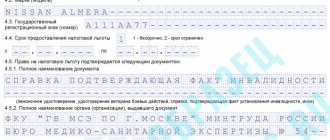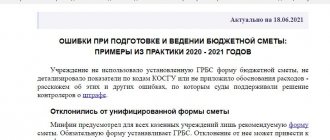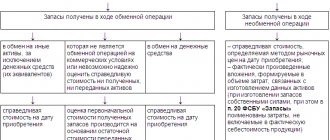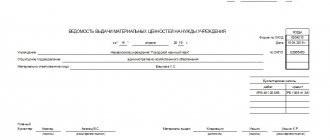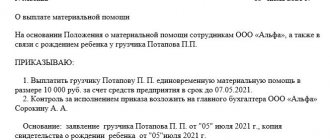Why recalculation is needed
Reasons causing the need to recalculate personal income tax:
- transferred wages for the past tax period;
- change in the calculation base (amount of accruals);
- submitting an application for the right to tax deductions late;
- and etc.
Excessive withholding of personal income tax from an employee’s income can be detected both by the taxpayer himself and by the tax agent. If excessive withholding is detected by the tax agent, in accordance with paragraph 1 of Art. 231 of the Tax Code of the Russian Federation, the taxpayer must be notified of this within 10 days from the date of discovery. Regardless of who discovered the overpayment, in order to return the tax, a written application from the taxpayer is required indicating the bank details for the transfer of funds.
Tax accounts
The following accounts are used to reflect transactions related to the calculation, accounting and payment of taxes:
- Account 19 reflects the amount of VAT on material assets acquired by the organization: fixed assets, intangible assets, inventories.
- Account 68 takes into account all payments for personal income tax, taxes on real estate, vehicles, income from transactions with securities, mining, environmental fees, fees for the use of natural resources, etc.
- Account 69 is used to record contributions to social insurance and security, health insurance, and contributions to the Pension Fund.
- Account 90 is intended for accounting for tax payments subject to return (reimbursement) after the sale of products, primarily VAT and excise taxes.
- Account 91 is used to reflect VAT and excise taxes related to sold tangible and intangible assets that were on the balance sheet of the enterprise.
- Account 99 is used to account for the company’s losses, which include paid income tax, penalties, fines for violations of the procedure and deadlines for accrual and payment.
Read more - Article on the payment of various taxes to the budget.
How to return personal income tax
Overpaid amounts can be returned to the institution’s personal account. To do this, you need to submit an application to the tax office, a sample of which can be found in the Federal Tax Service order dated February 14, 2017 No. ММВ-7-8/182. Also, payment orders and extracts from the personal income tax register must be attached to the application, which prove the excess tax amounts you contributed to the budget.
Note:
Some inspectorates do not accept the approved form if the tax agent has transferred more to the budget than was withheld or if the tax agent has paid the tax ahead of schedule, since in this case an overpayment occurs at the expense of the tax agent and not the taxpayer. To return such an overpayment, you must fill out a free form application.
How can these situations be reflected in the institution’s accounting records?
Situation 1.
An overpayment from federal funds that can either be returned or offset against arrears and future payments of other federal taxes.
In this case, the amount of funds transferred by the institution for the tax period exceeds the amounts withheld from taxpayers, and a receivable is formed in account 303.01 “Calculations for personal income tax.” The existing indicators will need to be reflected in the Information on accounts receivable and payable" (f. 0503769). Note that forms with receivables for account 303.01 may not be accepted by the financial authority, because in accordance with the Tax Code of the Russian Federation, legal entities are not taxpayers and do not have the right to transfer personal income tax at the expense of the corresponding budget. As a payer - tax agent, the tax is paid from funds withheld from employees from their income.
In budgetary institutions, the payment of excessive amounts of tax from subsidies received for the implementation of a state task or subsidies for other purposes can be regarded as misuse, which is an administrative offense and entails administrative liability for the officials who allowed it in the form of an administrative fine. In government institutions, such expenses will definitely be recognized as incomplete expenditure of budget funds.
If in 2022 an overpayment was discovered, confirmed by reconciliation of calculations, and the tax authority returned the amount of overpaid tax to the institution, this error is corrected in accounting using the “red reversal” method.
Example.
In 2022, the institution made the following entry regarding the withholding of excess tax from salaries: Dt X 302.11 837 Kt X 303 01 732.
In order to reflect the correction, it is necessary to use special accounts for correcting errors of previous years 304.86 and 304.96. In our case, the corrected correspondence will look like this:
- Dt X 302.11 837 Kt X 304.86 732 “red reversal”;
- Dt X 304.86 832 Kt X 303.01 732 “red reversal”.
The result of such postings is the debt of the Federal Tax Service to the institution and the debt of the institution to the employee.
Situation 2.
The employer, a budgetary institution, is obliged to return the overly withheld tax to the employee, and not take it into account in the current year.
It does not matter which KFO this situation will be reflected in, the main thing is that all business transactions for accrual and correction are reflected in one KFO. After the tax amount is returned to the employee, neither f. 0503737, neither f. 0503723 it will not be reflected.
Account correspondence:
- Dt X 201.11 510 Kt X 303.01 731 - tax refund;
- Dt X 302.11 837 Kt X 201.11 610 refund to the employee.
What to do if the tax was written off by mistake
The tax office has the right, without the approval of the taxpayer himself, to withdraw from him unpaid amounts of taxes, fines or penalties.
Sometimes such actions are carried out by mistake - for example, the authority did not receive a payment order, or the taxpayer himself made a mistake and indicated the wrong details, BCC number, etc.
If such an event does occur, then the tax office is obliged to return the unlawfully withheld amount. If the company has debts for any other taxes, then part of this payment can be used to pay them off, and the remaining funds will be returned.
To make a refund, you must submit a written application in free form to the Federal Tax Service. It must state the circumstances of the case, attach a supporting document (payment with tax transfer), and indicate bank details for the refund.
bukhproffi
Important! The application must be submitted within 1 month from the date of the unlawful write-off. If this period is missed, the amount can only be returned through legal proceedings.
Three years are allotted for this.
It takes 10 days to process the submitted application. Next, the authority is given 1 month to return the amount to the bank account.
Typical accounting entries for VAT refunds
Accounting and tax calculations are carried out on three accounts:
- Account 19 “VAT on purchased assets” is intended for accepting incoming taxes on supplies.
- 68.02 “Value added tax” is used for settlements with the budget.
- 90.03 “Value added tax” to include the tax in revenue (sales).
When an accountant forms a sales transaction, he includes VAT in the cost and enters it into the sales book:
- Dt 62.01 “Settlements with buyers” Kt 90.01 “Revenue” - the buyer’s debt is formed from the proceeds;
- Dt 90.03 “Value Added Tax” Kt 68.02 “Value Added Tax” - a fee on the cost of goods is charged as a debt to the budget.
When receiving documents from contractors for services rendered (work performed, etc.), the accounting department must deduct VAT and reflect it in the purchase book:
- Dt (23, , 26, 10, 44, 08) Kt 60 “Settlements with suppliers and contractors” - products, equipment are received, or the amount is written off as expenses, at the same time accounts payable are formed;
- Dt 19 Kt 60 - input tax is taken into account on the purchase price.
The VAT refund entries in accounting will be simple entries:
- Dt 68.02 Kt 19 - refundable VAT is restored.
- Dt 51 “Current accounts” Kt 68.02 - VAT refund received from the tax authorities.
What to do with overpayment?
According to subparagraph 5 of paragraph 1 of Article 21 of the Tax Code of the Russian Federation, a company has the right to a timely offset or refund of overpaid taxes, penalties and fines. The offset or return of the overpayment is regulated by Article 78 of the Tax Code of the Russian Federation.
To offset tax overpayments against upcoming payments for this or other taxes, you must submit an application to the tax authority. Please note: the offset of the amount of overpaid tax to pay off arrears on other taxes, arrears on penalties and (or) fines is carried out by the tax authorities independently.
The amount of overpaid tax is also subject to refund upon application by the company. In this case, the refund of the amount of overpayment if the company has arrears on other taxes of the corresponding type, as well as penalties, fines, is made only after the amount of overpaid tax is offset against the arrears.
Refund through court is also acceptable.
A statement of claim can be filed in court within three years, counting from the day when the taxpayer learned or should have learned about the fact of excessive tax collection (paragraph 2, paragraph 3, article 79 of the Tax Code of the Russian Federation).
At the same time, according to local inspectors, the taxpayer does not have the right to claim a refund of overpaid taxes in court if the decision of the tax authority on additional tax assessments is not appealed (as well as in the absence of an updated declaration of tax obligations). Under the above circumstances, there are no grounds for recognizing additional amounts accrued and paid by the taxpayer as excessively collected.
According to the AS MO (Resolution dated May 14, 2015 No. F05-5208/2015 in case No. A40-94772/14), clause 3 of Art. 79 of the Tax Code of the Russian Federation provides for the taxpayer the opportunity to choose a method of protecting his violated right in the event that the tax authority has collected excessive amounts of taxes from him. At the same time, the Tax Code does not indicate that the taxpayer has the right to file a claim in court, subject to pre-trial appeal to the tax authority regarding the return of illegally collected amounts. No other federal law has established a similar procedure.
The Supreme Court, in Ruling No. 304-KG16-3143 dated July 20, 2016, noted: such judicial methods of protecting the rights of taxpayers as challenging non-normative legal acts of tax authorities and claiming excessively collected taxes are independent, unless otherwise directly follows from the legislation. If there are several possible ways to protect a right, the taxpayer has the right to choose between them. Having chosen a specific method of protecting its right, a private entity must comply with the deadlines and procedures (including pre-trial ones) as they are established in relation to this method of protecting the right.
Referring to the legal positions contained in paragraph 65 of the Resolution of the Plenum of the Supreme Arbitration Court of the Russian Federation dated July 30, 2013 No. 57, paragraph 27 of the Resolution of the Plenum of the Supreme Arbitration Court of the Russian Federation dated May 12, 2016 No. 18, the Supreme Court of the Russian Federation emphasized: the provisions of the Tax Code do not contain special requirements for a mandatory pre-trial procedure settlement of such disputes. Since the organization paid taxes based on the decision of the inspectorate, it can raise the issue of returning the corresponding amounts as excessively collected (within the time limits established in Article 79 of the Tax Code of the Russian Federation), without separately appealing the decision made by the tax authority, and the court had to investigate the issue of legality decisions (see also Resolution of the AS SKO dated October 24, 2016 No. F08-6959/2016 in case No. A53-32154/2015).
How to identify overpaid taxes
As noted above, overpayment of tax can arise for a variety of reasons and can be identified either by the tax authorities or by the taxpayer himself.
Let's take a closer look at how to identify an overpayment by a taxpayer.
Many taxes require advance payments either monthly or quarterly. Therefore, overpayment of such taxes can be identified after the annual report has been compiled.
At the same time, many declarations require indications in the tax report of the amounts of advance payments and the amount of tax for the year, and therefore the report indicates the amount of the overpayment, if any.
The same situation arises if the report is clarified, as a result of which, due to a benefit or for some other reason (incorrect indication of the tax base), the amount of the taxpayer’s obligation to the budget is reduced.
Often, when transferring taxes, errors can be made in payment orders, so it is possible to identify overpayments of taxes if the money went to the wrong place by periodically checking with the budget for mutual settlements.
You can find out about the resulting surplus from the tax office or on your own:
- The inspector can call or send a letter. When calling, it is important to write down where they called from, for what tax and in what amount the overpayment was made. Sometimes the tax office may require additional documents to check whether it is really an overpayment. In this case, there is no point in refusing. Alas, tax authorities rarely report identified overpayments themselves.
- Through your personal account on the tax website. If an organization or individual entrepreneur has a qualified digital signature, you can open a personal taxpayer account for free. Through it, it is very convenient to track your relationship with the tax office - it will contain information not only about underpayments, but also overpaid amounts.
What to do to make a refund happen
However, it won't be easy to get him back. To do this, you need to go through several labor-intensive steps:
- provide a tax return with correct calculations;
- attach to it a purchase book and a sales book in which each invoice is recorded;
- submit an application for a refund to the Federal Tax Service in the prescribed form;
- provide primary documents reflected in the books for desk audit;
- be prepared for the fact that the fiscal authority will require additional documents from other persons.
Almost any materials can be requested, which is confirmed by the letter of the Federal Tax Service dated August 10, 2015 N SD-4-15/ [email protected]
For example, Phoenix LLC sold goods worth 14,123,546 rubles in the 1st quarter, including 18% VAT - 2,154,439.22 rubles. At the same time, the company purchased services in the amount of 16,854,798 rubles. Of these, 1,978,250 rubles were not taxed, since suppliers work under special regimes. Thus, taxable services and goods were received for 14,876,548 rubles, including VAT 18% - 2,269,303.93 rubles.
Accordingly, entries were made in the books of purchases and sales:
- Dt 68.02 Kt 19 - an entry was created in the purchase book in the amount of 2,269,303.93 rubles;
- Dt 90 Kt 68.02 - an entry was created in the sales book in the amount of 2,154,439.22 rubles.
The difference that should be reflected in the VAT return for the 1st quarter will be:
- 2,269,303.93 - 2,154,439.22 = 114,864.71 rubles.
- Dt 68.02 Kt 19 - 114,864.71 rubles were presented to the Federal Tax Service for reimbursement.
For a desk audit, the Federal Tax Service requested documents reflected in both books for the 1st quarter:
- contracts;
- invoices;
- payment orders for advances;
- certificates of work performed, services provided;
- invoices.
As a result of the check, several invoices with facsimile signatures in the amount of 24,000 rubles were discovered. Since this is a violation of the registration rules, but does not indicate fraud by the person being inspected, the Federal Tax Service decided to partially reimburse the tax with the deduction of incorrect documents:
- Dt 51 Kt 68.02 - 90,864.71 rubles were credited to the organization’s current account as a tax refund;
- Dt 19 Kt 68.02 - VAT restored for the amount of rejected invoices of 24,000 rubles;
- Dt 68.02 Kt 51 - arrears of VAT for the 1st quarter were paid to the budget in the amount of 24,000 rubles.

